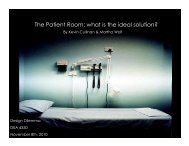The role of physical design and informal communication
The role of physical design and informal communication
The role of physical design and informal communication
Create successful ePaper yourself
Turn your PDF publications into a flip-book with our unique Google optimized e-Paper software.
Because patients on 6N have a particularly high <strong>physical</strong> need, the new NM saw a<br />
need for more assistive staff than licensed staff. Accordingly she changed the staffing<br />
matrix to 4 NAs on the day shift, 4 on the evening shift, <strong>and</strong> 2 on the night shift.<br />
However, the benefits <strong>of</strong> this change in staffing were not realized until after the<br />
completion <strong>of</strong> data collection because the hospital needed to hire employees to satisfy<br />
the new matrix, <strong>and</strong> this process that took months to complete.<br />
6N is known hospital-wide as being a noisy, chaotic unit, <strong>and</strong> this impacts<br />
both staff turnover as well as graduate nurse (GN) recruitment. <strong>The</strong> turnover on this<br />
unit is the highest among the medicine units in the hospital. Poor staffing as well as<br />
having an inappropriate mix <strong>of</strong> staff were cited by nurses as two causes for low<br />
employee satisfaction. It has been difficult to recruit nursing school graduates to 6N<br />
because they are leery <strong>of</strong> the high turnover reputation. One nurse hypothesized about<br />
the reason that GNs don’t want to work on the unit:<br />
“A lot <strong>of</strong> people don’t want to do this because you could be on a<br />
floor where you’re not running all the time.”<br />
<strong>The</strong> RNs’ (n=8) responses to the culture section <strong>of</strong> the survey indicated a<br />
generally positive perception <strong>of</strong> their working environment (Figure 17; see Appendix<br />
E for complete survey). <strong>The</strong> inter-item reliability <strong>of</strong> the culture section was<br />
calculated after the survey had been administered <strong>and</strong> found to be acceptable (n= 22;<br />
α = .91). <strong>The</strong> mean rating for all questions was 5.0 (σ=1.4) (on a 1-7 scale, where<br />
7=strongly agree); four questions had a mean rating below 5. Of those four, the two<br />
questions with the lowest mean ratings were “Nurses on my unit who learn new skills<br />
are rewarded” <strong>and</strong> “Doctors show respect for nurses on my unit,” with mean ratings<br />
<strong>of</strong> 3.38 ((σ=1.4) <strong>and</strong> 4.25 (σ=1.2) respectively. Responses to four <strong>of</strong> the five<br />
questions with the highest mean ratings indicate a culture that embraces learning <strong>and</strong><br />
62







